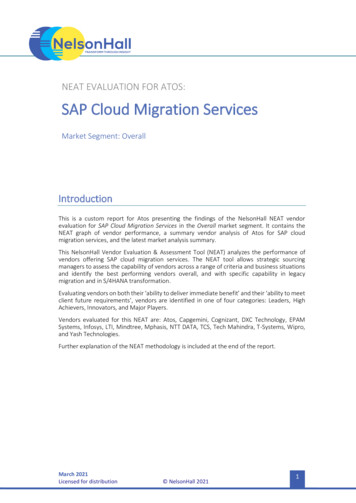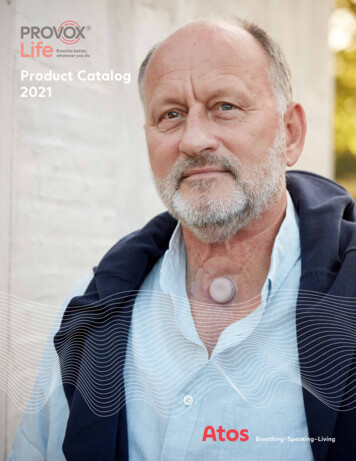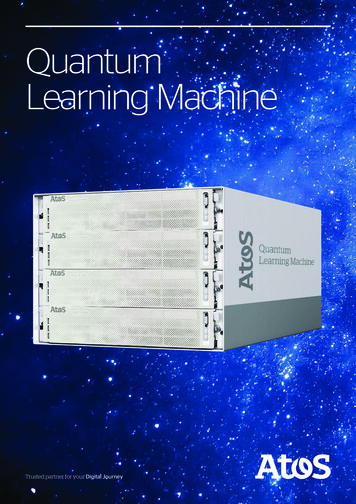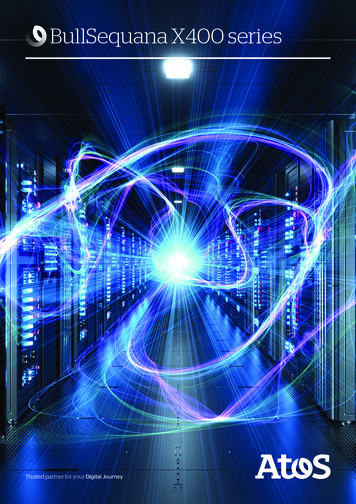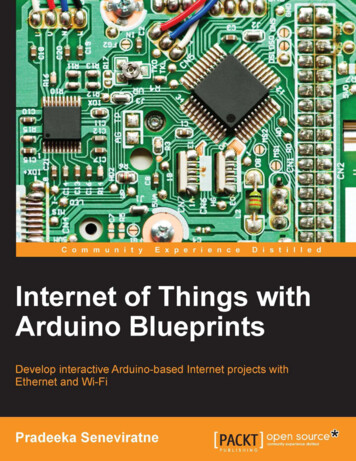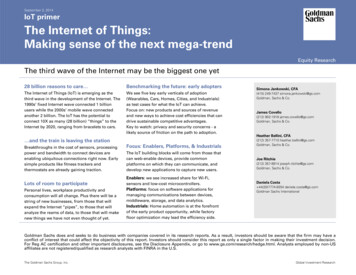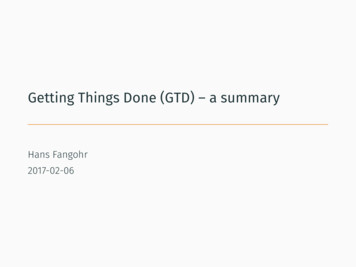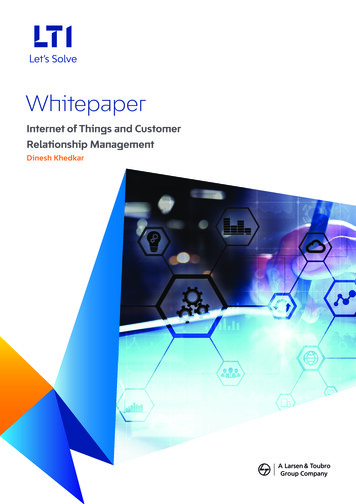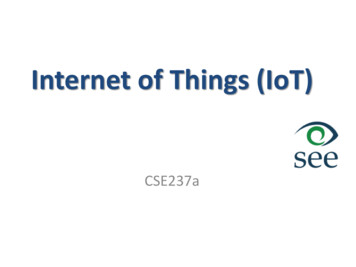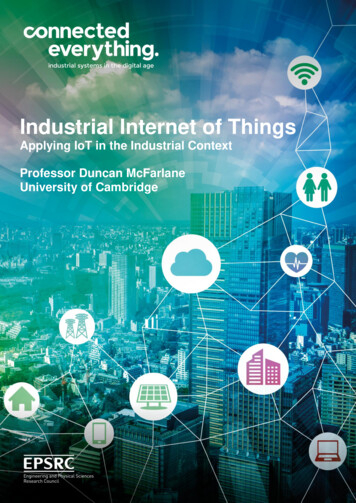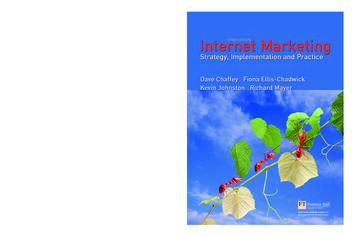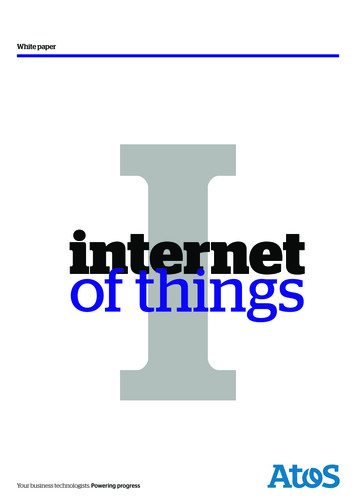
Transcription
White paperIinternetof thingsYour business technologists. Powering progress
Internet of ThingsThe Internet of Things (IoT) is expected to bethe next revolution following the World WideWeb. It will provide new bridges betweenreal life and the virtual world. The Internetwill no longer be merely a network of‘human brain’, but will integrate real-lifeobjects, sensors and physical activities.The associated technologies: wireless, miniaturization, batteries, networking, etc. are nowmature and cost effective enough to enableobjects to become connected and usher in thisnew era.The opportunities are huge and so are thechallenges:“One trillion nanoscale sensors and actuatorswill need the equivalent of 1000 Internets:the next huge demand for computing!”Peter Hartwell (HP).ContentsIntroductionCurrent Statuswithin AtosOpportunitiesConclusionChallengesNotesInternet of ThingsMaturity: FromExperiments toIndustrializationAbout the AuthorsDr Albrecht Becker: has more than 35 years ofexperience in IT. His core areas are Telecommunication, Enterprise Architecture.Grégoire Sénéclauze: is responsible for international business development for HTTS, beforejoining Atos Worldline, he worked for Orange inthe M2M and Wi-Fi domain.Purshottam Purswani: has more than 12 yearsof experience in IT. His core areas are smartgrids, enterprise integration.Sudharma Karekar: has more than nine yearsof experience in IT. His core areas are enterprisearchitecture and integration.Special thanks to James Fernandes for his valuable contributions to this paper.About the Atos Scientific CommunityThe Atos Scientific Community is a network ofsome 90 top scientists, representing a mix ofall skills and backgrounds, and coming fromall geographies where Atos operates. Publiclylaunched by Thierry Breton, Chairman and CEOof Atos, the establishment of this communityhighlights the importance of innovation in thedynamic IT services market and the need fora proactive approach to identify and anticipategame changing technologies.2Internet of Things
IntroductionAfter a long and tiring day at the office withthe drive home going to take the better halfof an hour, the last thing anyone would wantis to navigate the rush hour traffic. Wouldn’tit be nice if the car could simply drive itself?Such a ‘smart vehicle’ would be able to navigate by itself aided by an online signalingsystem. As soon as the vehicle pulled into theindividual’s driveway, it would signal ‘smarthome’ to put the coffee-machine and airconditioning on. By the time the individualturned the key in the door, the living roomtemperature would be a pleasant 20 andthe coffee ready. All they’d have to do is relaxon the couch. The above example is neitherscience fiction nor industry hype. It is justone of the things that the ‘Internet of Things’1(IoT) has in store.The Internet has evolved significantly since itsinception as an academic network of computers for a chosen few. Today, it is all-pervasiveand a source of information for everyone.Figure 1: Evolution of InternetCONNECTIVITYSensor networks & smart gridsare connecting people with objectsand objects with other objectsThese new information networks promise tocreate new business models, improve businessprocesses and reduce costs and risks.Vision-IoTThe vision of the IoT is to fuse the physical anddigital worlds by bringing different conceptsand technical components together. It aims tocreate a seamless network of billions of wirelessidentifiable objects that communicate with oneanother. This vision promises to create a newecosystem in which smart devices would beable direct their transport, adapt to their respective environments, self-configure, self-maintain,self-repair and eventually even play an activerole in their own disposal. They would be able toharvest the energy needed for their sustenance,adapt to changes in the environment and dealwith unforeseen circumstances. The IoT promises to raise the quality of human life to a wholenew level.Today, technological advances have broughtthis vision a step closer to reality. Small mobiletransceivers are already finding their way intosmart devices enabling new forms of communication, not only between humans, but betweenhumans and objects and between the objectsthemselves.A small network forthe priviliged few forsharing information19902010The Internet has become a consumer-oriented,interactive network, featuring shoppinggateways, e-tailing portals and entertainment;among other offerings.ConvergenceIn computing, the IoT, also known as the Internet of Objects, refers to the networked interconnection of everyday objects. It is described asa self-configuring wireless network of sensorswhose purpose would be to interconnect allthings.2 In the IoT, an object is connected toother objects over the Internet either as asource of information or as a consumer. Someobjects are also equipped with small computersand can process the information they receive.The IoT aims to create bridges between the‘Internet world’ and the ‘real world’: When anobject is connected to the Internet, the objectcreates a bridge between these two worlds.The IoT is not yet a tangible reality, but giventhe resources and attention being devoted to itthrough various initiatives around the world, itseems probable that the concept will become areality, in one form or another, in the very nearfuture.Sun’s John Flower quantifies this evolution interms of two mega trends: Reduced costs have brought with them theviability of connecting almost anything to thenetwork. This ubiquity of access will make it so thatpeople’s notions about what they interactwith will change dramatically.AnytimeAny contextComputingAnythingAnytimeAny deviceAnybodyCommunication over the Internet is no longerpredominantly initiated by human operatorssearching for information. Increasingly, ‘smartobjects’ like mobile phones are doing so independently.Internet of ThingsWhat is a Connected ObjectFigure 2: Vision - IoTNetwork where socialnetworks are connectingmore and more people1965Objects equipped with miniscule identifying devices have the potential to transform everydaylife. Such a system can make inventory management practically a thing of the past. Physicaltheft and loss would be impossible due to thefact that location of a device is known at alltimes. Smart meters can have a huge impact onthe way energy consumption is managed andthus reduce demand on sources of energy.ConnectivityInternetof ThingsAny serverAny businessAny placeAnywhereCommunicationContentAny pathAny networkCollection3
When a unique address is added to such an object, and this address maintains a presence overthe Internet, it becomes a connected object.This presence could be through an abstract reference or by directly connecting through Wi-Fi,Ethernet or 3G, thereby enabling the object toexchange information over the Internet.Any object can be connected to the Internet,either in an active mode or in a passive rPassive mode - In passive mode, the objectcarries identification, for example, through abarcode, RFID chip or some other machinereadable means of identification, but it is notconnected to Internet. At some point, something like a ‘tag reader’ identifies the object and‘publishes’ information on the Internet. The mainbenefit is the ability to enrich a context with theknowledge of the presence of the object at aparticular place, at a particular time and withinreach of particular users.Active mode - The other types of objects are‘active’ because more electronics are embedded in them to realize actions. These can be: Sensors: These objects have the capacity tomeasure something (position, temperature,air quality, movement, electricity consumption, etc.). In some cases, they may alsohave a degree of memory, enabling them torecord a certain number of measurements.For example, a sensor attached to a vehiclebroadcasts its speed, size and location toother vehicles in the vicinity. Presenters: These objects have the capacityto present some information to a human viaa screen, basic lights or sounds. For example,an object reader in a vehicle keeps track ofthe speed and location information broadcastby the gateways in the vehicles around it.This information can be used to inform thedriver that the vehicle ahead is slowing down(or speeding up).4 Gateways: These objects play the role ofenabling communication between devices.For example, they may communicate withvarious sensors, aggregate data, push it toward the Internet, and in return, will get otherdata to send to a presenter. For example inthe case above, an indicator (presenter) in thedashboard informs the driver of the decreasing distance between the two vehicles. Here,the communication gateway is wired. At thesame time, it also sends a signal to a regulatordevice (actuator) which controls the supply offuel to the engine. Actuators: These objects receive commands via gateways from somewhere on theInternet. Executing the command, the objectchanges its internal state or its behavior.For example, again in the case above, onreceiving information from the gateway,the actuator device cuts the supply of fuelto the engine, automatically slowing downthe vehicle, thus maintaining a safe distancebetween it and the vehicle ahead.Of course, an active object can handle morethan one of the described actions. For example,in a network of sensors, each sensor may alsobe a gateway which allows it to communicatewith another sensor and build an ad-hocmeshed network for simplified and cheaperInternet connectivity.NabaztagThe ‘Nabaztag’ is a fun object that canconnect to the internet via Wi-Fi. By movingits ears, changing colors, making soundsor speaking it can provide the weatherforecast or the number of unread mails,for example: http://www.nabaztag.com/en/index.html. The ears act as sensors as wellas presenters. Nabaztags can also communicate with other Nabaztags at other locations and have them respond to information sent from the first Nabaztag.Objects for Intelligent utWideNoise is the iPhone and iPod Touchapplication that samples decibel noise levels,and displays them on a worldwide interactivemap. It is also able to send this data to Twitterto be followed by other users.Objects for a Greener PlanetEnablers of the Internet ofThingsThe below section briefly highlights some of thefactors that enable the IoT.Human beings - They can act both as consumers and producers of data.Smart devices - Technological advances andreduction in the cost of manufacturing hasenabled the widespread use of smart devices.Figure 4: IoT EnablersCommunication networks, for example, Wi-Fi,GPRS, 3G, WirelessHART, Zigbee, Bluetooth, etc.,are the key denominator as they make a lotmore options available to the IoT.Cloud computing - Cloud computing is ableto scale rapidly to meet the growing demandresulting from the IoT in terms of storage andcomputing ommunicationnetworksInternet of Things
OpportunitiesAny technology evolution has an impacton industry and that remains true for theIoT as well. It brings a whole new paradigmfor companies and industries to takeadvantage of.IT Opportunities inIntegration SolutionsData Collection and BrokerageConnected objects would generate an incredible amount of data to be transferred, processedand stored. If historical data also needs to bestored, this problem is multiplied many-fold.Datacenters would need to scale accordingly tohandle this. This presents a great opportunity inthe field of data collection and brokerage.With technological advances in the field ofcloud computing, it may be a viable solutionto the data storage and processing problem.With the huge amount of data generated, thebrokerage platform also needs to be able toprovide expiration of data. It should be possibleto configure timelines for the data to expire andfor the data to be archived.The real-time nature of the IoT places a hugedemand on the processing capabilities of a databroker. Quantum computing4 can play a majorrole in addressing this issue. According to physicist David Deutsch, the parallelism associatedwith quantum computing allows a quantumcomputer to work on a million computationscompared to just one in a conventional computer. A 30-qubit quantum computer wouldequal the processing power of a conventionalcomputer that could run at 10 teraflops. Quantum Computing is a relatively recent development, but quite a few successful experimentshave been carried out.A concrete example for data collection andbrokerage, today, is the Pachube community.Pachube is a small start-up which has createda community of people sharing their entiresensor data. All data published on Pachube ispublicly available.Collaborative DecisionMakingAs seen above, vast amounts of data would begenerated by the IoT, much of which would beneeded in decision support situations. Automation tools would be required to go through thedata and help provide decisions and predictive analysis. At the same time, there is also aneed to share and present the data to supporthuman decision making. Collaborative DecisionInternet of ThingsMaking (CDM)5 is an approach that facilitatesdecision-making functions Opportunities by providing timely and accurate information essentialfor operational planning. This data can also beused to formulate ‘Pattern-Based Strategies’ byanalyzing usage and consumption patterns.And it provides the facility for predictive analysisin the event of unforeseen circumstances or disruption to operations and processes. This wouldbe an asset to the aviation industry whereexpensive buffers are incorporated into scheduling to absorb the consequences of unforeseencircumstances. It would translate roughly into acouple of million Euros saved per year.Smart Metershttp://www.metering.com/Smart meters with connection to theInternet would provide customers with‘signals’ about their electricity consumption, thereby encouraging them to adjusttheir consumption habits. It will help reduceemissions and bills.Objects for Intelligent HomesIntegrationSeamless integration of smart devices will playa vital role. For IT companies, there is an opportunity to provide an integration backboneplatform: Supporting different communication standards and protocols operating at differentfrequencies. Allowing different architectures, centralized ordistributed. Able to communicate with other networks. That should offer a high-level interface supporting Web-Service standards. Real-time service-oriented architecture (SOA)would be a promising solution. It will help ifeach device offers its functionality as a standardized service that allows other systems todiscover the services dynamically and invokethem easily.IT Opportunities inVarious SectorsThe IoT will impact most of an organization’sexisting customers. IoT innovation will bring anew dimension to the existing business modelsacross all sectors. Opportunities exist in manysectors, some of which are illustrated below. Although this doesn’t cover all sectors, it providesan overview of how users of today’s Internet willmove into the IoT.6Smart CitiesSmart Cities aim to make public service infrastructures and business processes significantlysmarter (i.e. more intelligent, more efficient,more sustainable) through tighter integration with Internet networking and computingcapabilities. Sensors deployed throughout thecity gather information about goods consumed,facilities used and other information pertainingto the life of the community. This informationis given to the city council to take appropriatesteps to improve the quality of life in the city.5
Automotive IndustrySome limited connecting capabilities have beenseen appearing in high-end cars in the pastyears, for instance, real-time traffic information.Expanding these capabilities to make the cara truly connected object will allow it to contactthe manufacturer to diagnose a malfunctionin real-time, or even better, anticipate it; beinformed of road hazards; negotiate chargingprices with power stations7; and book maintenance operations. Vehicle-to-vehicle (V2V) communication will open the road to collaborativedriving, addressing traffic issues from a global,rather than an individual standpoint, and willhelp find optimal solutions, relieving congestionand also averting collisions, leading to a decrease of road casualties. Google is developingself-piloted cars that are able to run 1,000 mileswithout human aid and about 14,000 miles withminimum human intervention.8Aviation SectorIn the aviation sector, the IoT can providesystemstatus monitoring for aircrafts via sensors that measure various conditions, such aspressure, vibration, temperature, etc. This datathen provides access to trends, maintenanceplanning and condition-based maintenance.RFID tags could be used for aircraft partshelping to prevent counterfeiting. At least 28accidents or incidents in the United States havebeen caused by counterfeits. There is importantongoing research about intelligent materials especially for aviation. These materials can detectand communicate with the maintenance teamwhen the structure is damaged.Energy SectorIn the energy sector, the IoT will help manageand monitor energy consumption. Smart appliances will be able to operate optimally, conserving energy and at the same time satisfying theend user’s need.RFID for Tracking andTracinghttp://www.rfidjournal.comSmart meters will send signals to customers toregulate their power consumption. This wouldresult in lower power consumption and alsolessen the burden on existing sources of energy.Both Procter & Gamble (P&G) and Wal-Martuse RFID tags to monitor goods from thetime they leave the warehouse to the timethey are bought by a consumer.Sensors placed at strategic nodes in a gas pipeline would send signals to the control centerinforming the controller about the pressure andvolume of gas flowing through at the node at agiven time.P&G and Wal-Mart hope to enrich theirexisting supply chain management systemwith this innovative solution.3Objects for Tracking and TracingManufacturingA lot of manufacturing companies are makinguse of RFID for tracking and tracing. Managinginventory is improved and easier. Tagging adevice also helps to avoid counterfeiting. Sensors attached to products can give informationabout their health allowing the user to decidewhen that device should be recycled. The Fordfactory in Cologne, Germany, currently uses barcodes tagged to the hood of a car to help determine the make of the car during production.The robots on the assembly line read the information on the bar code and then determinewhich parts are needed for that particular car.The parts are then sourced from the inventory.This allows Ford to use the same assembly lineto manufacture different cars.Efficiency at airports could be achieved by providing luggage tagged with RFID which helpsin tracking the movement of luggage duringtransit.6Internet of Things
ChallengesToday, connected objects are still in theirearly stages and there are still many challenges to be overcome before the benefits ofconnected objects can be fully realized.Addressing and TaggingThe IoT should be able to tag or address about50 to 100 trillion objects. To achieve this, thecurrent IPv4 protocol will be insufficient. A keychallenge is to agree on a common way of addressing and identifying objects.It is also important to have unique UIDs (userids), even for mass- produced objects (i.e. allobjects coming out of a factory will have theirown unique UID, not a common one). The relationship between objects, such as raw material(one UID) becoming refined material (anotherUID) or parts (each with their own UID) thatare then assembled as a car (again a differentUID) also needs to be considered to enable usto follow these relationships and thus maintaintraceability.ConnectivityWhen dealing with the IoT, one usually concentrates on the devices themselves. Connectivity is often missed, which is a big mistake.Connectivity in the IoT will mostly be wireless,using many possible solutions (Wi-Fi, GPRS, 3G,WirelessHART, Zigbee, Bluetooth, etc.) As eachof these solutions has different pros and cons,they will likely all coexist in the future. (Zigbeerequires very little power, but has a limitedrange; 3G has almost complete coverage, butis expensive both in terms of hardware andusage).When using 3G, there is usually a cost associated with the usage of data transmission. It istherefore important to optimize communicationwith devices.An adaptive ad-hoc network with mesh-routingcapabilities is also a promising answer for theconnectivity issue. In such a network, each ‘object’ is also a router capable of routing messages from and to other sensors. Such an approachallows the connectivity cost to be reduced andalso simplifies the deployment phase. However,objects need to have more computing power inorder to act as ‘gateways’.Openness and Data ModelStandardsToday, many examples of connected objectsexist and some are already in production, likeautomatic meter reading, customer electronics,etc. All rely on a vertical and closed ecosystem.Internet of ThingsBut this represents a short-term vision, as history has always shown that Challenges morestandardization and openness creates newecosystems, with many more opportunities forall actors in the end. If all connected objects andsensors were to be accessible in a more ‘open’and ‘standard’ way, then, the same objectswould have more than one ‘connected usage’.That would be a good incentive for end usersto exploit the opportunities provided by moreconnected objects which in turn would be anincentive for service providers to develop newservices using these objects. The ‘extra cost’ fora connected object would be shared by all theservices and functionalities brought by its openconnectivity.There are two major areas of standardizationfor the IoT:Semantic: This will describe how to communicate with objects and what to expect fromthem. As there could be many different kinds ofobjects, which are possibly (and hopefully) longlasting, then the semantic must be time-proof.Communication protocols: As pointed out byElgar Fleisch, a global standard protocol, identification and addressing scheme for bridging thelast mile from the Internet to the smart objectwould be required. For the IoT to be adoptedwidely, a standard needs to be establishedwhich serves as guidelines for individual implementations and interactions between them.There are two main approaches foraddressing: EPC (Electronic Product Code) namespace is a coding scheme that was introduced for RFID in order to complementthe barcode scheme operated by theGS1. EPC allows for the unique identification of objects and not for classes of objects, unlike barcodes which are identicalfor all similar objects. IPV6 is the future scheme of the Internetaddressing scheme which can provideeach individual person on earth withmore than 40 billion objects. Each address is coded using 128 bits as opposedto 32bits as with the existing Internetprotocol.Open Geospatial Consortium (OGC) isdeveloping interoperability interfacespecifications for the real-time integration ofheterogeneous sensors and the information infrastructure.9SWE (Sensor Web Enablement) is an OGCopen standard which is drawing attentionoutside the geo-information world.Security and Privacy(vs. Simplification)SecurityOne of the key components used in the IoT,RFIDs, are the ones most susceptible to attack.The situation becomes more difficult when theattack is of an active nature. Secure identifyingprotocols are being developed to counter thesethreats10.Another alternative is to provide tagged deviceswith unique UIDs. As the device transitions fromone phase to another, the UID associated withthe device also changes. This also calls for otherdevices and actuators in the ‘trusted’ network tobe made aware of the device’s changed UID.PrivacyOne of the main concerns that the IoT has toaddress is privacy. The most important challenge in convincing users to adopt emergingtechnologies is the protection of data andprivacy. Concerns over privacy and data protection are widespread, particularly as sensors andsmart tags can track users’ movements, habitsand ongoing preferences.7
Invisible and constant data exchange betweenthings and people, and between things andother things, will take place unknown to theowners and originators of such data. IoT implementations would need to decide who controlsthe data and for how long. The fact that in theIoT a lot of data flows autonomously and without human knowledge makes it very importantto have authorization protocols in place to avoidmisuse of data. To promote a more widespreadadoption of the technologies underlying the IoT,principles of informed consent, data confidentiality and security must be safeguarded. Thesekind of issues are addressed by the EPC-ISgroup.Moreover, protecting privacy must not belimited to technical solutions, but encompassregulatory, market based and socio-ethicalconsiderations. Unless there are concerted efforts involving all government, civil society andprivate sector players to protect these values,the development of the IoT will be hamperedif not prevented. It is only through awarenessof these technological advances, and thechallenges they present, that we can seize thefuture benefits of a fair and user-centric IoT.HardwareThe price and availability of the requiredhardware is today the key challenge preventingcompanies and end users from having more‘connected objects’. Today the limitations on thehardware are: Battery life: Having connected objects canease everyday life, but if one has to ‘think’of recharging all everyday objects, it willbecome too much work compared to thebenefit.subnet of smart electricity meters of a utilitycompany or a subnet of air pollution measurement points in a city. The subnets will be managed by independent operators that providetheir data over the Internet, either themselvesor via mediators. The role of the mediator is toprovide a uniform interface for all sensors andactuators and their heterogeneous interfacetechnologies.There is an open-source project calledArduino (http://www.arduino.cc/) which isdesigning a cheap, easy-to-use platform(hard soft) for connecting objects.Such devices can be useful for realizingproof of concepts and for large projects,as there are no associated license fees orroyalties.Different Complex Event Processing (CEP)12 andBusiness Process Management (BPM)13 modelsalso need to be considered when deciding onthe overall architecture for the system. Data andcontext brokers aggregate and correlate eventsthat draw attention to changes in sensor measurements. They operate like complex eventprocessors and can initiate actions to triggerfunctions in IoT applications or to control actuators, depending on conditions met in the streamof events. IoT applications use the aggregatedresults derived from event streams.Figure 2: Arduino BoardComputing PowerThe real-time nature of the IoT also poses achallenge in the amount of computing powerrequired since about 50 to 100 trillion objectswould share data. This is completely differentfrom a normal desktop where a user uses acomputer for a specific need. Contemporarycomputing models based on human-computerinteraction are inadequate and inappropriate forubiquitous computing. Vastly parallel systemscapable of performing calculations orders ofmagnitude higher would be required. Cloudcomputing enables dynamic distribution ofworkload among elements of the cloud basedon the availability of storage and computingfacilities. Hardware size: the new connected objectsshould not be much bigger than their nonconnected counterparts. Radio connectivity: this element is of coursecrucial. If a user is using RFID, which isbecoming quite cheap and may not requirebatteries, then they will have to install extraequipment to ‘discuss’ with objects.ArchitectureFigure 6: IoT ArchitectureSensors /ActuatorsSensor Network OperatorSensor Data ProviderAnalysts differ on the kind of architecture11 thatthe IoT would use. Would it be event-driven ormodel-driven?8Sensor Network Operator MediatorsSensor Data ProviderSubscriptionsWould it be a combination of both? Model-driven and functional approaches will coexist withnew approaches able to handle exceptions andunusual evolutions of processes.It can be expected that there will be more thanone logical sensor/actuator network wherethings communicate directly with server applications. There will be many fields of independent sensor/actuator (sub)nets, for example aSensor Network OperatorSensor Data ProviderData / elationApplicationApplicationData / icationApplicationsInternet of Things
Internet of things maturity: from experimentsto industrializationAs IoT implementation matures, humanintervention is to a large extent reduced andthe Internet of machines increases. Based onthe projects implemented in the area of the IoT,implementation can be associated with differentinnovation levels. Each IoT implementationcould be associated with one of the followinglevels: Level 1: Measurement or basic Level:Organizations make use of automation fordata recording only. There are no automatedactions executed based on these measurements. For example, electricity meters for apower grid company. Level 2: Automation level: Organizationsuse the above information and automatically execute business processes. This levelincludes deciding which systems, processesor operations will leverage the data. Forinstance, energy providers could install smartmeters and inform consumers in real timeabout their energy consumption. To movefrom level 1 to level 2, organizations need toundertake sufficient data analysis in level 1 soas to achieve maximum return on investment. Level 3: Bu
2 Internet of Things Current Status within Atos Conclusion Notes Internet of Things The Internet of Things (IoT) is expected to be the next revolution following the World Wide Web. It will provide new bridges between real life and the virtual world. The Internet will no longer be merely a network of 'human brain', but will integrate real-life
